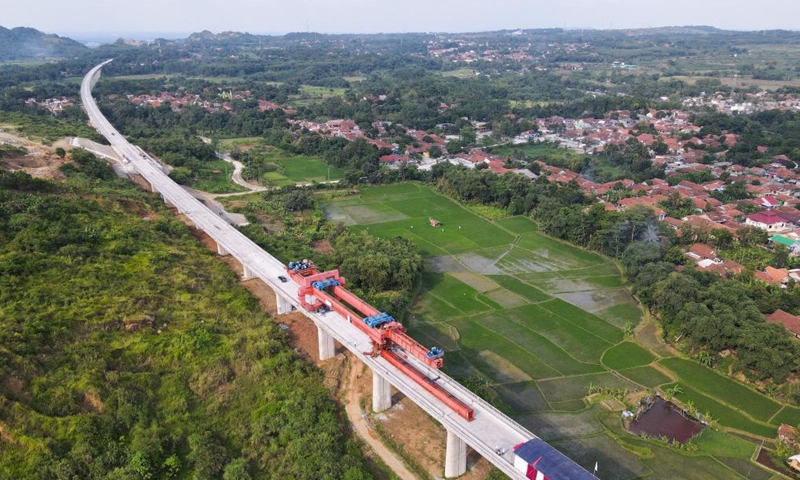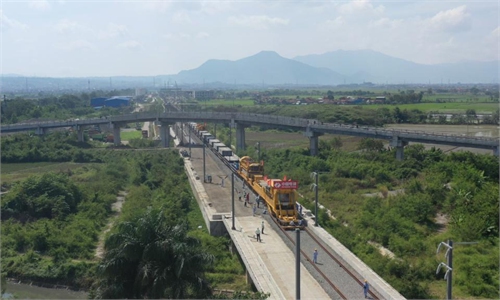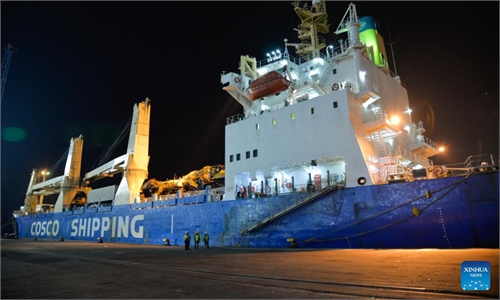Erection of box girders complete on Jakarta-Bandung high-speed rail, laying foundation for 2023 launch

Aerial photo taken on Oct. 16, 2022 shows the construction site of the erection of the last box girder on the Jakarta-Bandung High-Speed Railway in Purwakarta, Indonesia.Photo:Xinhua
With the last 900-ton simple girder falling steadily into place on the No 24 bridge of the Jakarta-Bandung High-speed Railway on Sunday, the task of erecting box girders on the whole rail line was completed with the 13 tunnels fully opened, laying a solid foundation for the start of project operation in June 2023, the Xinhua News Agency reported.
The railway, which connects Jakarta and Bandung, the fourth-largest city in Indonesia, is a flagship project under the China-proposed Belt and Road Initiative (BRI). It's also the first overseas construction project that fully uses Chinese railway systems, technology and industrial components.
The total length of the railway is 142 kilometers, with three beam yards, No 1, No 2 and No 4, which were responsible for the erection of 2,558 box girders that are generally used in bridges with large spans. The No 1 and No 4 yards completed the erection of the box girders in June and September, respectively, this year.
The construction group overcame challenges that included the lagging transfer of the roadbed as well as the oversized slope of the girder erection, and completed the erection task on schedule, representing a successful conclusion to the erection of box girders for the whole rail line.
The erection of all 2,558 box girders along the line has been completed, along with all 13 tunnels. Over 92 percent of the subgrade, bridge and other works have also been completed, Xinhua said.
The completion of the bridge erection as well as the opening of the track-laying channel is a sign that the construction of the basic infrastructure of the Jakarta-Bandung High-speed Railway has been completed, and the next step is to power up and enter the trial operation phase of the train, Sun Zhang, a railway expert at Shanghai Tongji University, told the Global Times on Monday.
After the completion of the project, travel time from Jakarta to Bandung will be shortened from more than 3 hours to 40 minutes, which will help bolster Indonesia's economic development and deepen bilateral cooperation, while promoting the high-quality development of the BRI, experts said.
Sun noted that the railway is expected to further meet the demand for land and sea transportation of the countries joining the BRI, as well as strengthen interconnection with China-Europe freight trains and build a fast global transportation network.
Since the beginning of 2022, the landmark project has moved forward steadily despite obstacles including complex geology and the COVID-19 pandemic.
On September 1, the first shipment of China-made high-speed trains including one high-speed electric passenger train and one inspection train tailored for the project arrived at Jakarta Port, marking a key step for the operation of the railway.
Indonesian President Joko Widodo visited the construction site for Tegalluar station, the last station of the railway, on October 13, saying that the construction achievements will be presented to the world during the upcoming G20 Bali Summit, a symbol of cooperation between China and Indonesia.
"The Jakarta-Bandung High-speed Railway is a good showcase of Chinese railroad technology. Amid fierce competition with other countries, China's railroad plans are cost-effective with the principle of mutual benefit, so the country has certain advantages in the international market," Sun noted.


